Leadership Strategies and Challenges for Volunteering WA
VerifiedAdded on 2022/09/05
|10
|2732
|20
Essay
AI Summary
This essay analyzes the management and leadership of Volunteering WA, a non-profit organization. It explores key challenges such as changing government regulations, funding issues, and volunteer retention, along with internal and external factors affecting the organization. The essay examines various leadership styles, including autocratic, democratic, and laissez-faire approaches, and suggests a mixed approach for effective management. It highlights the differences between leadership and management, emphasizing the importance of both for achieving organizational goals. Additionally, the essay discusses the challenges faced by managers and leaders in dealing with cultural issues, knowledge gaps, and volunteer attrition. The study concludes that a combination of leadership styles, along with effective management practices, is crucial for the success of Volunteering WA.

MANAGEMENT IN COMMUNITY SERVICES
STUDENT DETAILS
STUDENT DETAILS
STUDENT DETAILS
STUDENT DETAILS
Paraphrase This Document
Need a fresh take? Get an instant paraphrase of this document with our AI Paraphraser
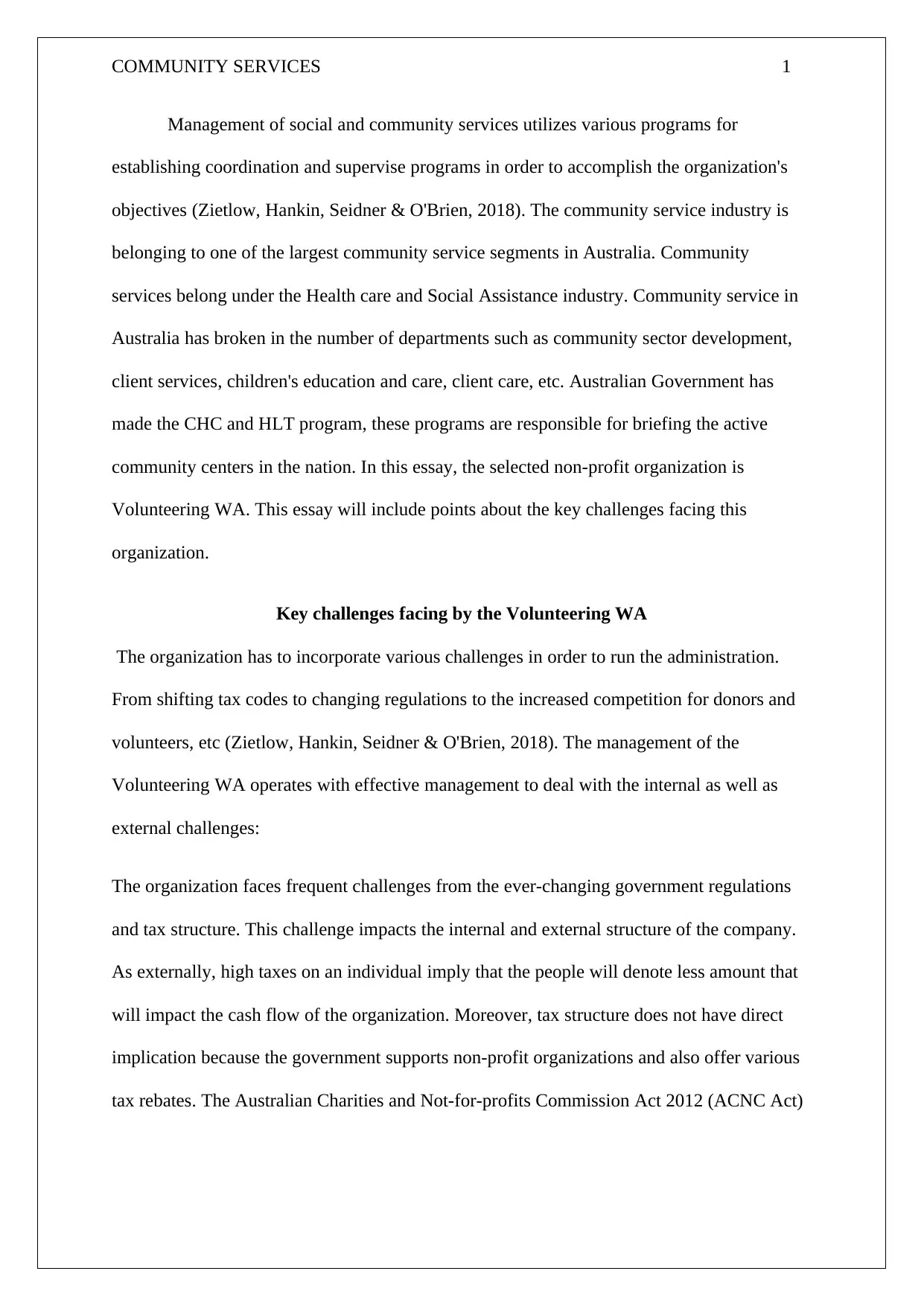
COMMUNITY SERVICES 1
Management of social and community services utilizes various programs for
establishing coordination and supervise programs in order to accomplish the organization's
objectives (Zietlow, Hankin, Seidner & O'Brien, 2018). The community service industry is
belonging to one of the largest community service segments in Australia. Community
services belong under the Health care and Social Assistance industry. Community service in
Australia has broken in the number of departments such as community sector development,
client services, children's education and care, client care, etc. Australian Government has
made the CHC and HLT program, these programs are responsible for briefing the active
community centers in the nation. In this essay, the selected non-profit organization is
Volunteering WA. This essay will include points about the key challenges facing this
organization.
Key challenges facing by the Volunteering WA
The organization has to incorporate various challenges in order to run the administration.
From shifting tax codes to changing regulations to the increased competition for donors and
volunteers, etc (Zietlow, Hankin, Seidner & O'Brien, 2018). The management of the
Volunteering WA operates with effective management to deal with the internal as well as
external challenges:
The organization faces frequent challenges from the ever-changing government regulations
and tax structure. This challenge impacts the internal and external structure of the company.
As externally, high taxes on an individual imply that the people will denote less amount that
will impact the cash flow of the organization. Moreover, tax structure does not have direct
implication because the government supports non-profit organizations and also offer various
tax rebates. The Australian Charities and Not-for-profits Commission Act 2012 (ACNC Act)
Management of social and community services utilizes various programs for
establishing coordination and supervise programs in order to accomplish the organization's
objectives (Zietlow, Hankin, Seidner & O'Brien, 2018). The community service industry is
belonging to one of the largest community service segments in Australia. Community
services belong under the Health care and Social Assistance industry. Community service in
Australia has broken in the number of departments such as community sector development,
client services, children's education and care, client care, etc. Australian Government has
made the CHC and HLT program, these programs are responsible for briefing the active
community centers in the nation. In this essay, the selected non-profit organization is
Volunteering WA. This essay will include points about the key challenges facing this
organization.
Key challenges facing by the Volunteering WA
The organization has to incorporate various challenges in order to run the administration.
From shifting tax codes to changing regulations to the increased competition for donors and
volunteers, etc (Zietlow, Hankin, Seidner & O'Brien, 2018). The management of the
Volunteering WA operates with effective management to deal with the internal as well as
external challenges:
The organization faces frequent challenges from the ever-changing government regulations
and tax structure. This challenge impacts the internal and external structure of the company.
As externally, high taxes on an individual imply that the people will denote less amount that
will impact the cash flow of the organization. Moreover, tax structure does not have direct
implication because the government supports non-profit organizations and also offer various
tax rebates. The Australian Charities and Not-for-profits Commission Act 2012 (ACNC Act)
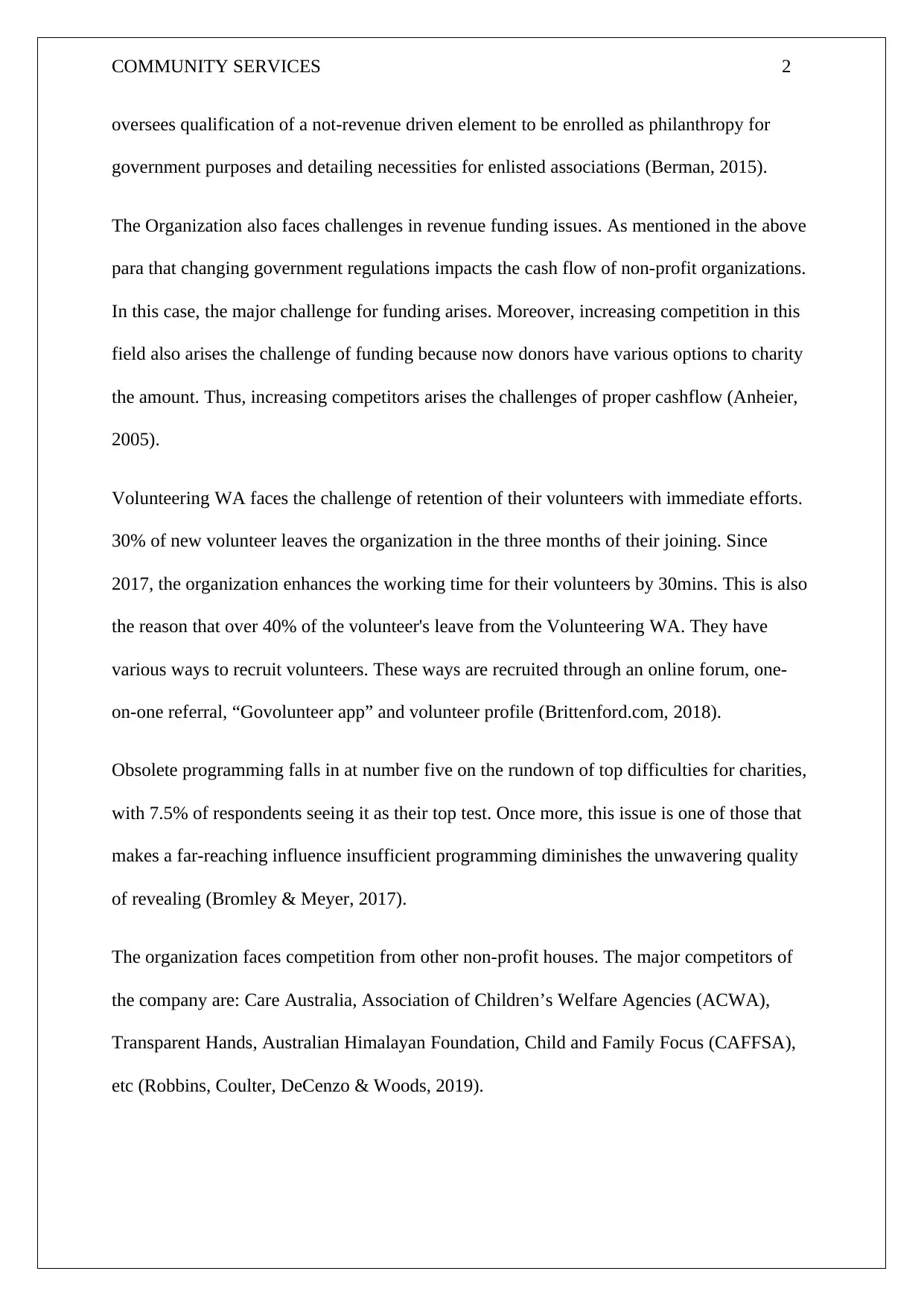
COMMUNITY SERVICES 2
oversees qualification of a not-revenue driven element to be enrolled as philanthropy for
government purposes and detailing necessities for enlisted associations (Berman, 2015).
The Organization also faces challenges in revenue funding issues. As mentioned in the above
para that changing government regulations impacts the cash flow of non-profit organizations.
In this case, the major challenge for funding arises. Moreover, increasing competition in this
field also arises the challenge of funding because now donors have various options to charity
the amount. Thus, increasing competitors arises the challenges of proper cashflow (Anheier,
2005).
Volunteering WA faces the challenge of retention of their volunteers with immediate efforts.
30% of new volunteer leaves the organization in the three months of their joining. Since
2017, the organization enhances the working time for their volunteers by 30mins. This is also
the reason that over 40% of the volunteer's leave from the Volunteering WA. They have
various ways to recruit volunteers. These ways are recruited through an online forum, one-
on-one referral, “Govolunteer app” and volunteer profile (Brittenford.com, 2018).
Obsolete programming falls in at number five on the rundown of top difficulties for charities,
with 7.5% of respondents seeing it as their top test. Once more, this issue is one of those that
makes a far-reaching influence insufficient programming diminishes the unwavering quality
of revealing (Bromley & Meyer, 2017).
The organization faces competition from other non-profit houses. The major competitors of
the company are: Care Australia, Association of Children’s Welfare Agencies (ACWA),
Transparent Hands, Australian Himalayan Foundation, Child and Family Focus (CAFFSA),
etc (Robbins, Coulter, DeCenzo & Woods, 2019).
oversees qualification of a not-revenue driven element to be enrolled as philanthropy for
government purposes and detailing necessities for enlisted associations (Berman, 2015).
The Organization also faces challenges in revenue funding issues. As mentioned in the above
para that changing government regulations impacts the cash flow of non-profit organizations.
In this case, the major challenge for funding arises. Moreover, increasing competition in this
field also arises the challenge of funding because now donors have various options to charity
the amount. Thus, increasing competitors arises the challenges of proper cashflow (Anheier,
2005).
Volunteering WA faces the challenge of retention of their volunteers with immediate efforts.
30% of new volunteer leaves the organization in the three months of their joining. Since
2017, the organization enhances the working time for their volunteers by 30mins. This is also
the reason that over 40% of the volunteer's leave from the Volunteering WA. They have
various ways to recruit volunteers. These ways are recruited through an online forum, one-
on-one referral, “Govolunteer app” and volunteer profile (Brittenford.com, 2018).
Obsolete programming falls in at number five on the rundown of top difficulties for charities,
with 7.5% of respondents seeing it as their top test. Once more, this issue is one of those that
makes a far-reaching influence insufficient programming diminishes the unwavering quality
of revealing (Bromley & Meyer, 2017).
The organization faces competition from other non-profit houses. The major competitors of
the company are: Care Australia, Association of Children’s Welfare Agencies (ACWA),
Transparent Hands, Australian Himalayan Foundation, Child and Family Focus (CAFFSA),
etc (Robbins, Coulter, DeCenzo & Woods, 2019).
⊘ This is a preview!⊘
Do you want full access?
Subscribe today to unlock all pages.

Trusted by 1+ million students worldwide
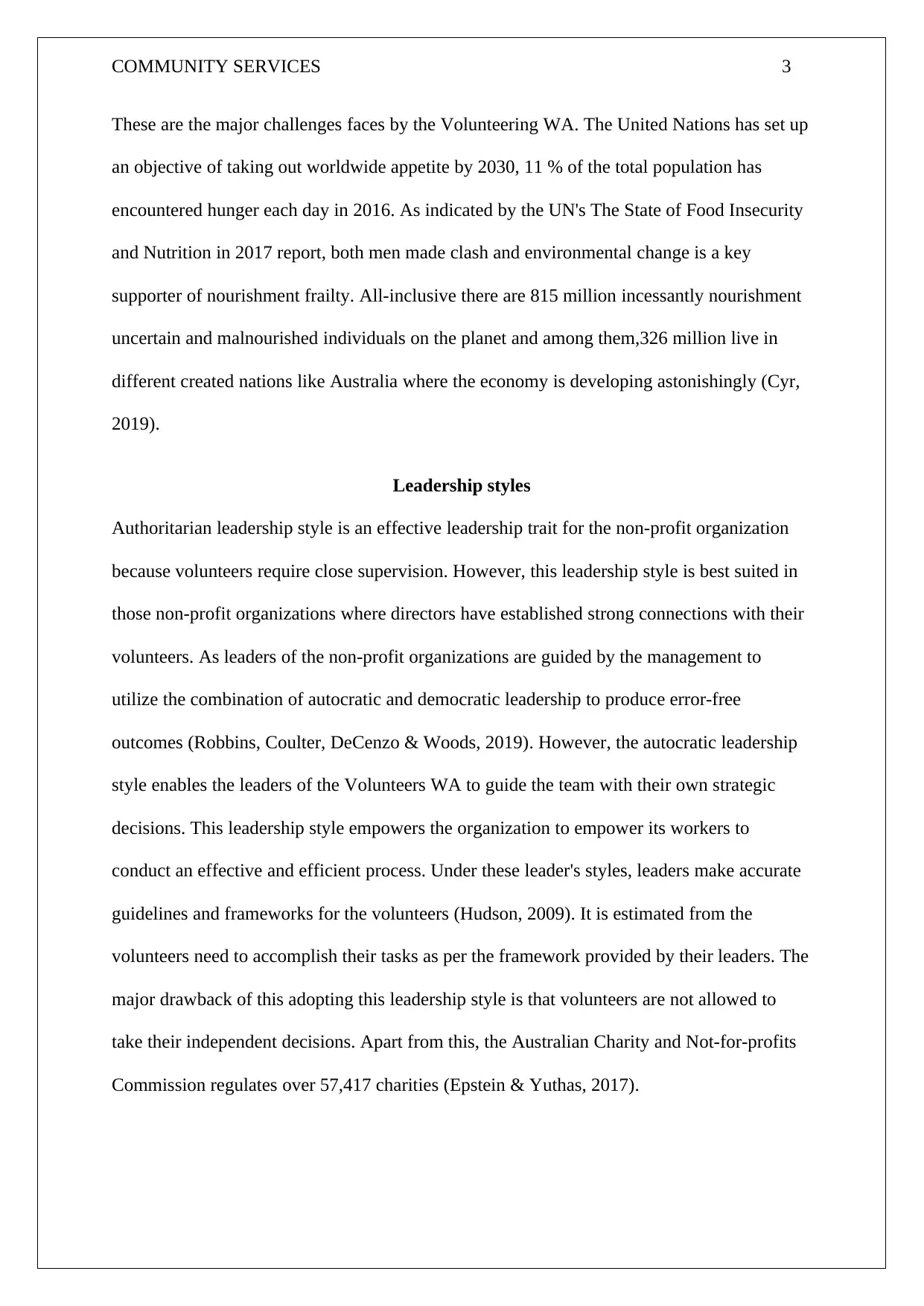
COMMUNITY SERVICES 3
These are the major challenges faces by the Volunteering WA. The United Nations has set up
an objective of taking out worldwide appetite by 2030, 11 % of the total population has
encountered hunger each day in 2016. As indicated by the UN's The State of Food Insecurity
and Nutrition in 2017 report, both men made clash and environmental change is a key
supporter of nourishment frailty. All-inclusive there are 815 million incessantly nourishment
uncertain and malnourished individuals on the planet and among them,326 million live in
different created nations like Australia where the economy is developing astonishingly (Cyr,
2019).
Leadership styles
Authoritarian leadership style is an effective leadership trait for the non-profit organization
because volunteers require close supervision. However, this leadership style is best suited in
those non-profit organizations where directors have established strong connections with their
volunteers. As leaders of the non-profit organizations are guided by the management to
utilize the combination of autocratic and democratic leadership to produce error-free
outcomes (Robbins, Coulter, DeCenzo & Woods, 2019). However, the autocratic leadership
style enables the leaders of the Volunteers WA to guide the team with their own strategic
decisions. This leadership style empowers the organization to empower its workers to
conduct an effective and efficient process. Under these leader's styles, leaders make accurate
guidelines and frameworks for the volunteers (Hudson, 2009). It is estimated from the
volunteers need to accomplish their tasks as per the framework provided by their leaders. The
major drawback of this adopting this leadership style is that volunteers are not allowed to
take their independent decisions. Apart from this, the Australian Charity and Not-for-profits
Commission regulates over 57,417 charities (Epstein & Yuthas, 2017).
These are the major challenges faces by the Volunteering WA. The United Nations has set up
an objective of taking out worldwide appetite by 2030, 11 % of the total population has
encountered hunger each day in 2016. As indicated by the UN's The State of Food Insecurity
and Nutrition in 2017 report, both men made clash and environmental change is a key
supporter of nourishment frailty. All-inclusive there are 815 million incessantly nourishment
uncertain and malnourished individuals on the planet and among them,326 million live in
different created nations like Australia where the economy is developing astonishingly (Cyr,
2019).
Leadership styles
Authoritarian leadership style is an effective leadership trait for the non-profit organization
because volunteers require close supervision. However, this leadership style is best suited in
those non-profit organizations where directors have established strong connections with their
volunteers. As leaders of the non-profit organizations are guided by the management to
utilize the combination of autocratic and democratic leadership to produce error-free
outcomes (Robbins, Coulter, DeCenzo & Woods, 2019). However, the autocratic leadership
style enables the leaders of the Volunteers WA to guide the team with their own strategic
decisions. This leadership style empowers the organization to empower its workers to
conduct an effective and efficient process. Under these leader's styles, leaders make accurate
guidelines and frameworks for the volunteers (Hudson, 2009). It is estimated from the
volunteers need to accomplish their tasks as per the framework provided by their leaders. The
major drawback of this adopting this leadership style is that volunteers are not allowed to
take their independent decisions. Apart from this, the Australian Charity and Not-for-profits
Commission regulates over 57,417 charities (Epstein & Yuthas, 2017).
Paraphrase This Document
Need a fresh take? Get an instant paraphrase of this document with our AI Paraphraser
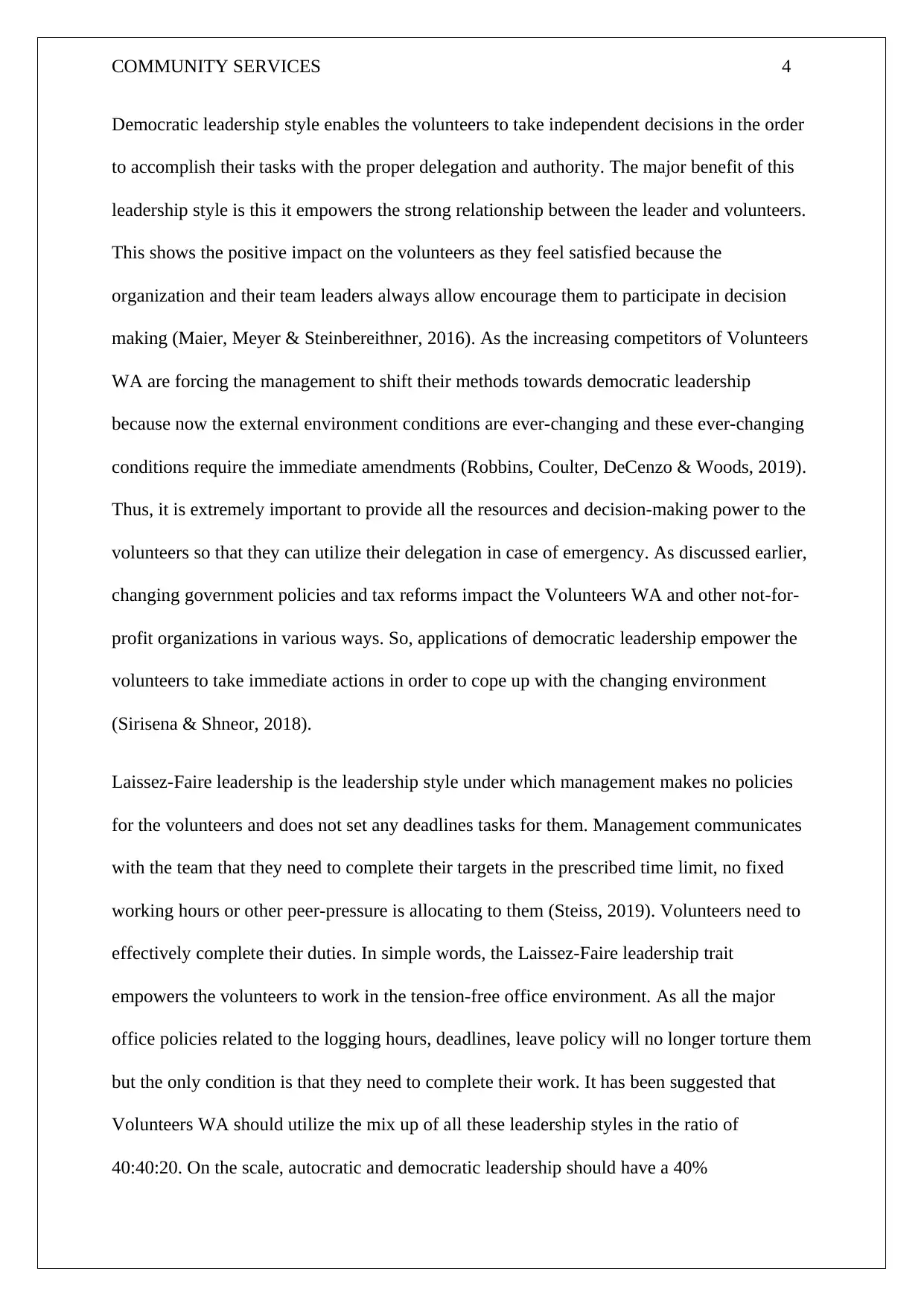
COMMUNITY SERVICES 4
Democratic leadership style enables the volunteers to take independent decisions in the order
to accomplish their tasks with the proper delegation and authority. The major benefit of this
leadership style is this it empowers the strong relationship between the leader and volunteers.
This shows the positive impact on the volunteers as they feel satisfied because the
organization and their team leaders always allow encourage them to participate in decision
making (Maier, Meyer & Steinbereithner, 2016). As the increasing competitors of Volunteers
WA are forcing the management to shift their methods towards democratic leadership
because now the external environment conditions are ever-changing and these ever-changing
conditions require the immediate amendments (Robbins, Coulter, DeCenzo & Woods, 2019).
Thus, it is extremely important to provide all the resources and decision-making power to the
volunteers so that they can utilize their delegation in case of emergency. As discussed earlier,
changing government policies and tax reforms impact the Volunteers WA and other not-for-
profit organizations in various ways. So, applications of democratic leadership empower the
volunteers to take immediate actions in order to cope up with the changing environment
(Sirisena & Shneor, 2018).
Laissez-Faire leadership is the leadership style under which management makes no policies
for the volunteers and does not set any deadlines tasks for them. Management communicates
with the team that they need to complete their targets in the prescribed time limit, no fixed
working hours or other peer-pressure is allocating to them (Steiss, 2019). Volunteers need to
effectively complete their duties. In simple words, the Laissez-Faire leadership trait
empowers the volunteers to work in the tension-free office environment. As all the major
office policies related to the logging hours, deadlines, leave policy will no longer torture them
but the only condition is that they need to complete their work. It has been suggested that
Volunteers WA should utilize the mix up of all these leadership styles in the ratio of
40:40:20. On the scale, autocratic and democratic leadership should have a 40%
Democratic leadership style enables the volunteers to take independent decisions in the order
to accomplish their tasks with the proper delegation and authority. The major benefit of this
leadership style is this it empowers the strong relationship between the leader and volunteers.
This shows the positive impact on the volunteers as they feel satisfied because the
organization and their team leaders always allow encourage them to participate in decision
making (Maier, Meyer & Steinbereithner, 2016). As the increasing competitors of Volunteers
WA are forcing the management to shift their methods towards democratic leadership
because now the external environment conditions are ever-changing and these ever-changing
conditions require the immediate amendments (Robbins, Coulter, DeCenzo & Woods, 2019).
Thus, it is extremely important to provide all the resources and decision-making power to the
volunteers so that they can utilize their delegation in case of emergency. As discussed earlier,
changing government policies and tax reforms impact the Volunteers WA and other not-for-
profit organizations in various ways. So, applications of democratic leadership empower the
volunteers to take immediate actions in order to cope up with the changing environment
(Sirisena & Shneor, 2018).
Laissez-Faire leadership is the leadership style under which management makes no policies
for the volunteers and does not set any deadlines tasks for them. Management communicates
with the team that they need to complete their targets in the prescribed time limit, no fixed
working hours or other peer-pressure is allocating to them (Steiss, 2019). Volunteers need to
effectively complete their duties. In simple words, the Laissez-Faire leadership trait
empowers the volunteers to work in the tension-free office environment. As all the major
office policies related to the logging hours, deadlines, leave policy will no longer torture them
but the only condition is that they need to complete their work. It has been suggested that
Volunteers WA should utilize the mix up of all these leadership styles in the ratio of
40:40:20. On the scale, autocratic and democratic leadership should have a 40%
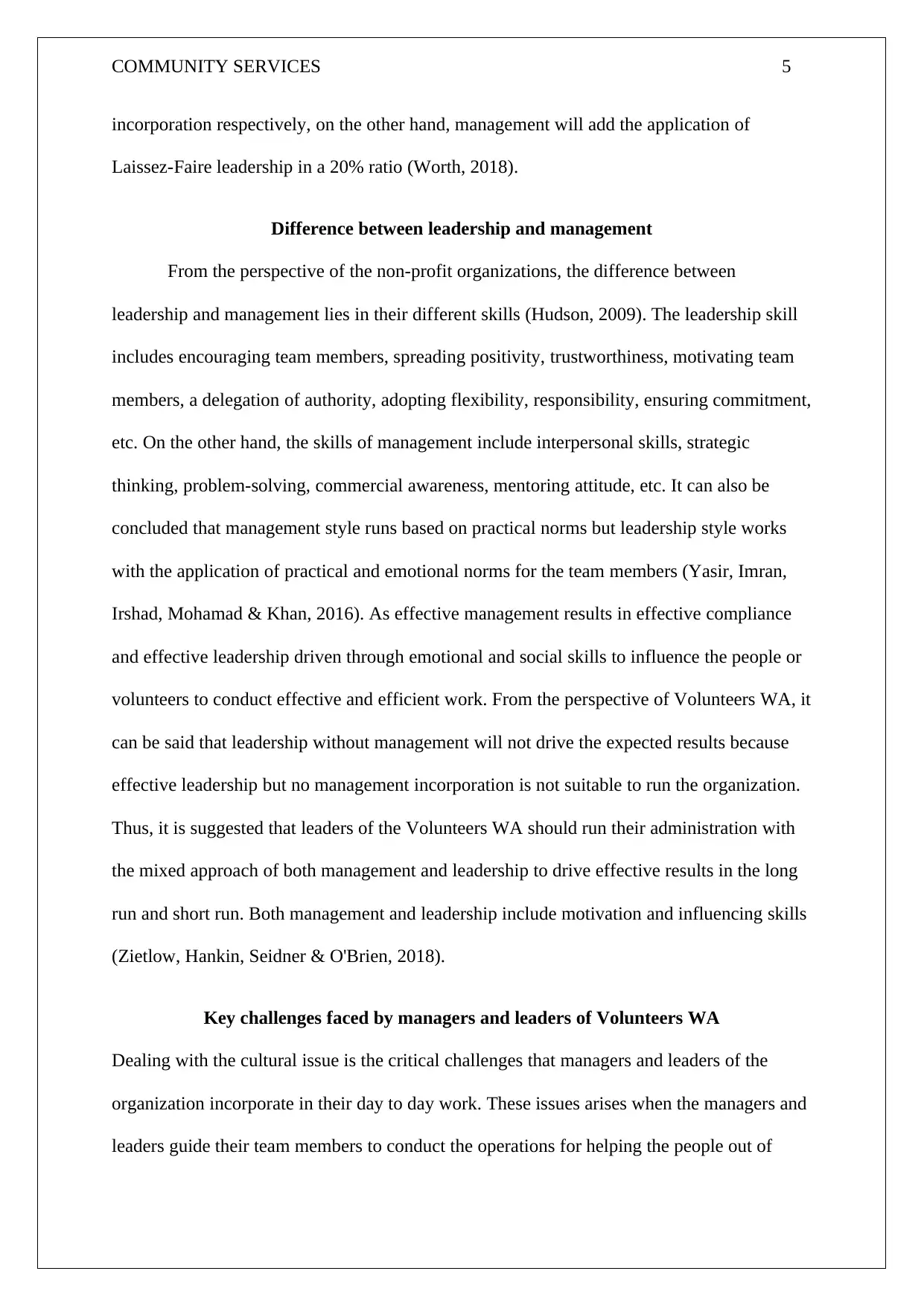
COMMUNITY SERVICES 5
incorporation respectively, on the other hand, management will add the application of
Laissez-Faire leadership in a 20% ratio (Worth, 2018).
Difference between leadership and management
From the perspective of the non-profit organizations, the difference between
leadership and management lies in their different skills (Hudson, 2009). The leadership skill
includes encouraging team members, spreading positivity, trustworthiness, motivating team
members, a delegation of authority, adopting flexibility, responsibility, ensuring commitment,
etc. On the other hand, the skills of management include interpersonal skills, strategic
thinking, problem-solving, commercial awareness, mentoring attitude, etc. It can also be
concluded that management style runs based on practical norms but leadership style works
with the application of practical and emotional norms for the team members (Yasir, Imran,
Irshad, Mohamad & Khan, 2016). As effective management results in effective compliance
and effective leadership driven through emotional and social skills to influence the people or
volunteers to conduct effective and efficient work. From the perspective of Volunteers WA, it
can be said that leadership without management will not drive the expected results because
effective leadership but no management incorporation is not suitable to run the organization.
Thus, it is suggested that leaders of the Volunteers WA should run their administration with
the mixed approach of both management and leadership to drive effective results in the long
run and short run. Both management and leadership include motivation and influencing skills
(Zietlow, Hankin, Seidner & O'Brien, 2018).
Key challenges faced by managers and leaders of Volunteers WA
Dealing with the cultural issue is the critical challenges that managers and leaders of the
organization incorporate in their day to day work. These issues arises when the managers and
leaders guide their team members to conduct the operations for helping the people out of
incorporation respectively, on the other hand, management will add the application of
Laissez-Faire leadership in a 20% ratio (Worth, 2018).
Difference between leadership and management
From the perspective of the non-profit organizations, the difference between
leadership and management lies in their different skills (Hudson, 2009). The leadership skill
includes encouraging team members, spreading positivity, trustworthiness, motivating team
members, a delegation of authority, adopting flexibility, responsibility, ensuring commitment,
etc. On the other hand, the skills of management include interpersonal skills, strategic
thinking, problem-solving, commercial awareness, mentoring attitude, etc. It can also be
concluded that management style runs based on practical norms but leadership style works
with the application of practical and emotional norms for the team members (Yasir, Imran,
Irshad, Mohamad & Khan, 2016). As effective management results in effective compliance
and effective leadership driven through emotional and social skills to influence the people or
volunteers to conduct effective and efficient work. From the perspective of Volunteers WA, it
can be said that leadership without management will not drive the expected results because
effective leadership but no management incorporation is not suitable to run the organization.
Thus, it is suggested that leaders of the Volunteers WA should run their administration with
the mixed approach of both management and leadership to drive effective results in the long
run and short run. Both management and leadership include motivation and influencing skills
(Zietlow, Hankin, Seidner & O'Brien, 2018).
Key challenges faced by managers and leaders of Volunteers WA
Dealing with the cultural issue is the critical challenges that managers and leaders of the
organization incorporate in their day to day work. These issues arises when the managers and
leaders guide their team members to conduct the operations for helping the people out of
⊘ This is a preview!⊘
Do you want full access?
Subscribe today to unlock all pages.

Trusted by 1+ million students worldwide
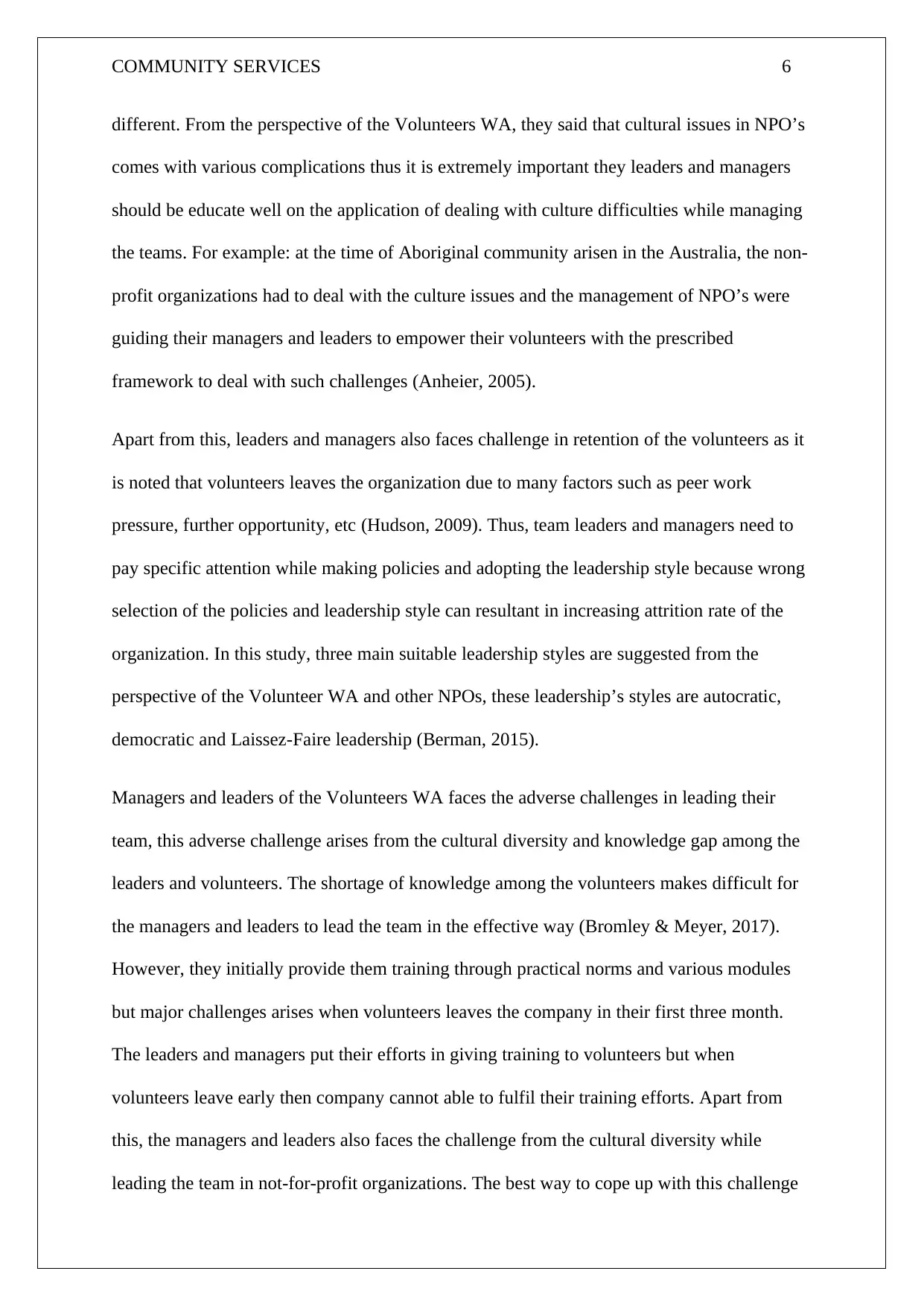
COMMUNITY SERVICES 6
different. From the perspective of the Volunteers WA, they said that cultural issues in NPO’s
comes with various complications thus it is extremely important they leaders and managers
should be educate well on the application of dealing with culture difficulties while managing
the teams. For example: at the time of Aboriginal community arisen in the Australia, the non-
profit organizations had to deal with the culture issues and the management of NPO’s were
guiding their managers and leaders to empower their volunteers with the prescribed
framework to deal with such challenges (Anheier, 2005).
Apart from this, leaders and managers also faces challenge in retention of the volunteers as it
is noted that volunteers leaves the organization due to many factors such as peer work
pressure, further opportunity, etc (Hudson, 2009). Thus, team leaders and managers need to
pay specific attention while making policies and adopting the leadership style because wrong
selection of the policies and leadership style can resultant in increasing attrition rate of the
organization. In this study, three main suitable leadership styles are suggested from the
perspective of the Volunteer WA and other NPOs, these leadership’s styles are autocratic,
democratic and Laissez-Faire leadership (Berman, 2015).
Managers and leaders of the Volunteers WA faces the adverse challenges in leading their
team, this adverse challenge arises from the cultural diversity and knowledge gap among the
leaders and volunteers. The shortage of knowledge among the volunteers makes difficult for
the managers and leaders to lead the team in the effective way (Bromley & Meyer, 2017).
However, they initially provide them training through practical norms and various modules
but major challenges arises when volunteers leaves the company in their first three month.
The leaders and managers put their efforts in giving training to volunteers but when
volunteers leave early then company cannot able to fulfil their training efforts. Apart from
this, the managers and leaders also faces the challenge from the cultural diversity while
leading the team in not-for-profit organizations. The best way to cope up with this challenge
different. From the perspective of the Volunteers WA, they said that cultural issues in NPO’s
comes with various complications thus it is extremely important they leaders and managers
should be educate well on the application of dealing with culture difficulties while managing
the teams. For example: at the time of Aboriginal community arisen in the Australia, the non-
profit organizations had to deal with the culture issues and the management of NPO’s were
guiding their managers and leaders to empower their volunteers with the prescribed
framework to deal with such challenges (Anheier, 2005).
Apart from this, leaders and managers also faces challenge in retention of the volunteers as it
is noted that volunteers leaves the organization due to many factors such as peer work
pressure, further opportunity, etc (Hudson, 2009). Thus, team leaders and managers need to
pay specific attention while making policies and adopting the leadership style because wrong
selection of the policies and leadership style can resultant in increasing attrition rate of the
organization. In this study, three main suitable leadership styles are suggested from the
perspective of the Volunteer WA and other NPOs, these leadership’s styles are autocratic,
democratic and Laissez-Faire leadership (Berman, 2015).
Managers and leaders of the Volunteers WA faces the adverse challenges in leading their
team, this adverse challenge arises from the cultural diversity and knowledge gap among the
leaders and volunteers. The shortage of knowledge among the volunteers makes difficult for
the managers and leaders to lead the team in the effective way (Bromley & Meyer, 2017).
However, they initially provide them training through practical norms and various modules
but major challenges arises when volunteers leaves the company in their first three month.
The leaders and managers put their efforts in giving training to volunteers but when
volunteers leave early then company cannot able to fulfil their training efforts. Apart from
this, the managers and leaders also faces the challenge from the cultural diversity while
leading the team in not-for-profit organizations. The best way to cope up with this challenge
Paraphrase This Document
Need a fresh take? Get an instant paraphrase of this document with our AI Paraphraser
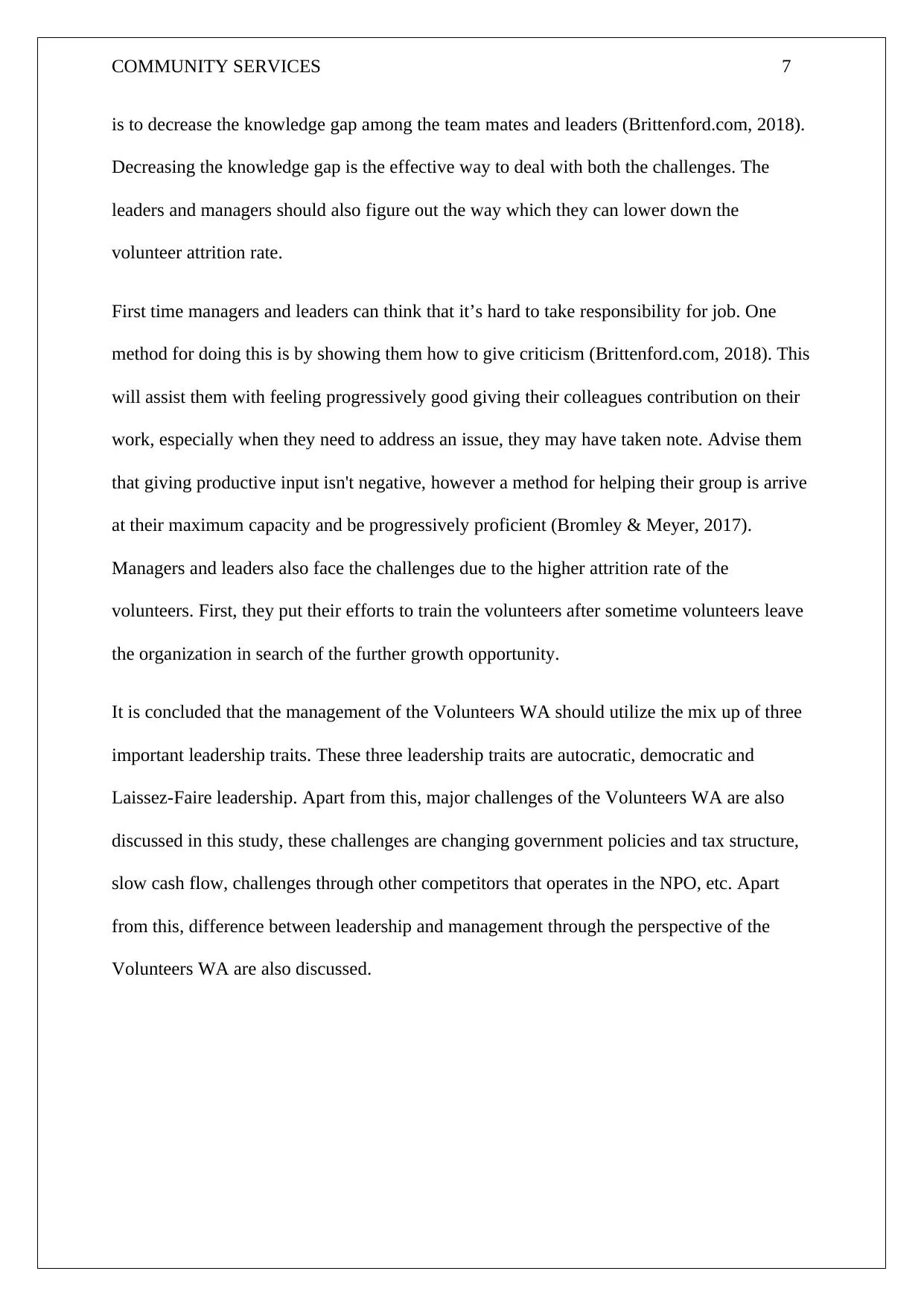
COMMUNITY SERVICES 7
is to decrease the knowledge gap among the team mates and leaders (Brittenford.com, 2018).
Decreasing the knowledge gap is the effective way to deal with both the challenges. The
leaders and managers should also figure out the way which they can lower down the
volunteer attrition rate.
First time managers and leaders can think that it’s hard to take responsibility for job. One
method for doing this is by showing them how to give criticism (Brittenford.com, 2018). This
will assist them with feeling progressively good giving their colleagues contribution on their
work, especially when they need to address an issue, they may have taken note. Advise them
that giving productive input isn't negative, however a method for helping their group is arrive
at their maximum capacity and be progressively proficient (Bromley & Meyer, 2017).
Managers and leaders also face the challenges due to the higher attrition rate of the
volunteers. First, they put their efforts to train the volunteers after sometime volunteers leave
the organization in search of the further growth opportunity.
It is concluded that the management of the Volunteers WA should utilize the mix up of three
important leadership traits. These three leadership traits are autocratic, democratic and
Laissez-Faire leadership. Apart from this, major challenges of the Volunteers WA are also
discussed in this study, these challenges are changing government policies and tax structure,
slow cash flow, challenges through other competitors that operates in the NPO, etc. Apart
from this, difference between leadership and management through the perspective of the
Volunteers WA are also discussed.
is to decrease the knowledge gap among the team mates and leaders (Brittenford.com, 2018).
Decreasing the knowledge gap is the effective way to deal with both the challenges. The
leaders and managers should also figure out the way which they can lower down the
volunteer attrition rate.
First time managers and leaders can think that it’s hard to take responsibility for job. One
method for doing this is by showing them how to give criticism (Brittenford.com, 2018). This
will assist them with feeling progressively good giving their colleagues contribution on their
work, especially when they need to address an issue, they may have taken note. Advise them
that giving productive input isn't negative, however a method for helping their group is arrive
at their maximum capacity and be progressively proficient (Bromley & Meyer, 2017).
Managers and leaders also face the challenges due to the higher attrition rate of the
volunteers. First, they put their efforts to train the volunteers after sometime volunteers leave
the organization in search of the further growth opportunity.
It is concluded that the management of the Volunteers WA should utilize the mix up of three
important leadership traits. These three leadership traits are autocratic, democratic and
Laissez-Faire leadership. Apart from this, major challenges of the Volunteers WA are also
discussed in this study, these challenges are changing government policies and tax structure,
slow cash flow, challenges through other competitors that operates in the NPO, etc. Apart
from this, difference between leadership and management through the perspective of the
Volunteers WA are also discussed.
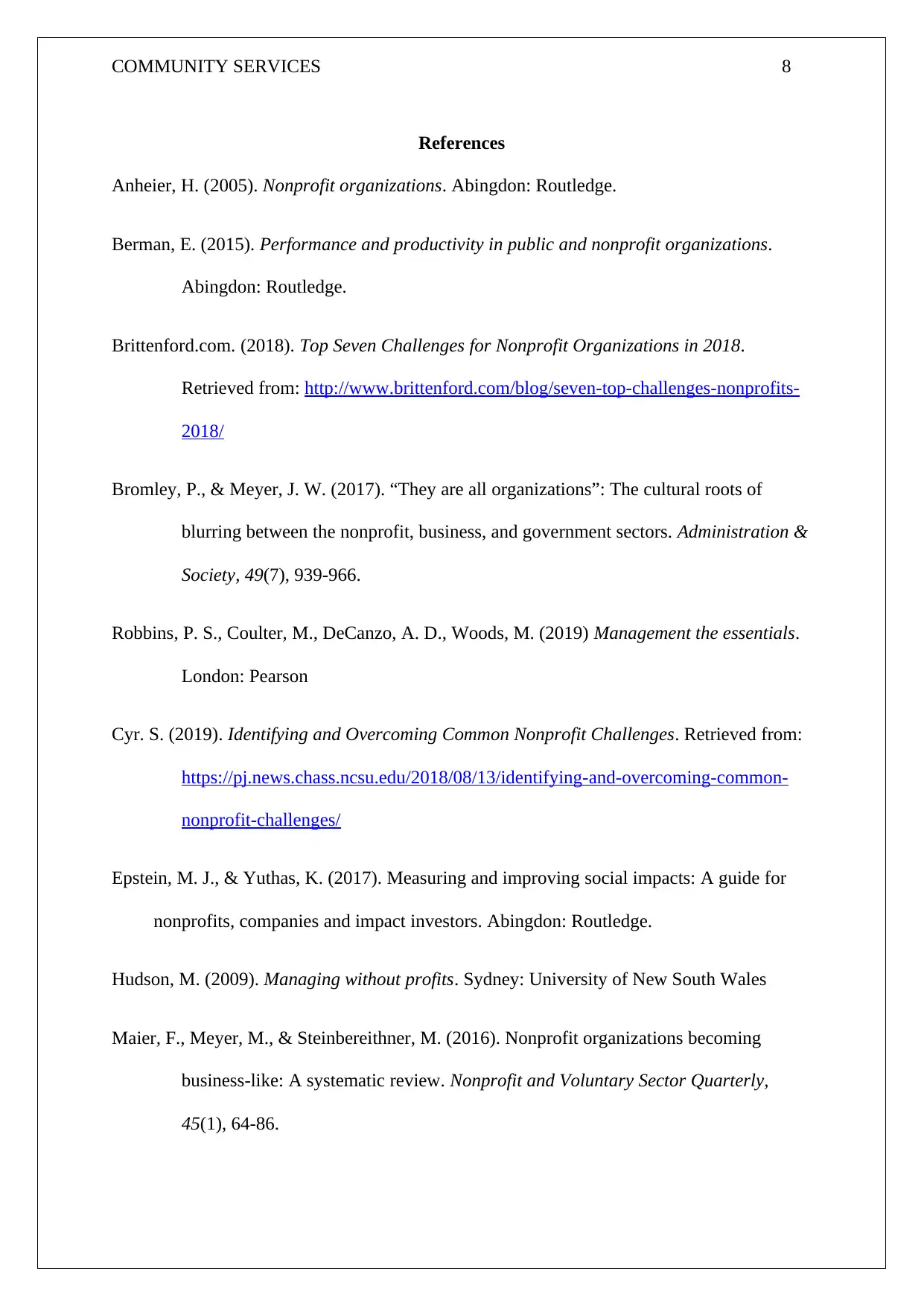
COMMUNITY SERVICES 8
References
Anheier, H. (2005). Nonprofit organizations. Abingdon: Routledge.
Berman, E. (2015). Performance and productivity in public and nonprofit organizations.
Abingdon: Routledge.
Brittenford.com. (2018). Top Seven Challenges for Nonprofit Organizations in 2018.
Retrieved from: http://www.brittenford.com/blog/seven-top-challenges-nonprofits-
2018/
Bromley, P., & Meyer, J. W. (2017). “They are all organizations”: The cultural roots of
blurring between the nonprofit, business, and government sectors. Administration &
Society, 49(7), 939-966.
Robbins, P. S., Coulter, M., DeCanzo, A. D., Woods, M. (2019) Management the essentials.
London: Pearson
Cyr. S. (2019). Identifying and Overcoming Common Nonprofit Challenges. Retrieved from:
https://pj.news.chass.ncsu.edu/2018/08/13/identifying-and-overcoming-common-
nonprofit-challenges/
Epstein, M. J., & Yuthas, K. (2017). Measuring and improving social impacts: A guide for
nonprofits, companies and impact investors. Abingdon: Routledge.
Hudson, M. (2009). Managing without profits. Sydney: University of New South Wales
Maier, F., Meyer, M., & Steinbereithner, M. (2016). Nonprofit organizations becoming
business-like: A systematic review. Nonprofit and Voluntary Sector Quarterly,
45(1), 64-86.
References
Anheier, H. (2005). Nonprofit organizations. Abingdon: Routledge.
Berman, E. (2015). Performance and productivity in public and nonprofit organizations.
Abingdon: Routledge.
Brittenford.com. (2018). Top Seven Challenges for Nonprofit Organizations in 2018.
Retrieved from: http://www.brittenford.com/blog/seven-top-challenges-nonprofits-
2018/
Bromley, P., & Meyer, J. W. (2017). “They are all organizations”: The cultural roots of
blurring between the nonprofit, business, and government sectors. Administration &
Society, 49(7), 939-966.
Robbins, P. S., Coulter, M., DeCanzo, A. D., Woods, M. (2019) Management the essentials.
London: Pearson
Cyr. S. (2019). Identifying and Overcoming Common Nonprofit Challenges. Retrieved from:
https://pj.news.chass.ncsu.edu/2018/08/13/identifying-and-overcoming-common-
nonprofit-challenges/
Epstein, M. J., & Yuthas, K. (2017). Measuring and improving social impacts: A guide for
nonprofits, companies and impact investors. Abingdon: Routledge.
Hudson, M. (2009). Managing without profits. Sydney: University of New South Wales
Maier, F., Meyer, M., & Steinbereithner, M. (2016). Nonprofit organizations becoming
business-like: A systematic review. Nonprofit and Voluntary Sector Quarterly,
45(1), 64-86.
⊘ This is a preview!⊘
Do you want full access?
Subscribe today to unlock all pages.

Trusted by 1+ million students worldwide
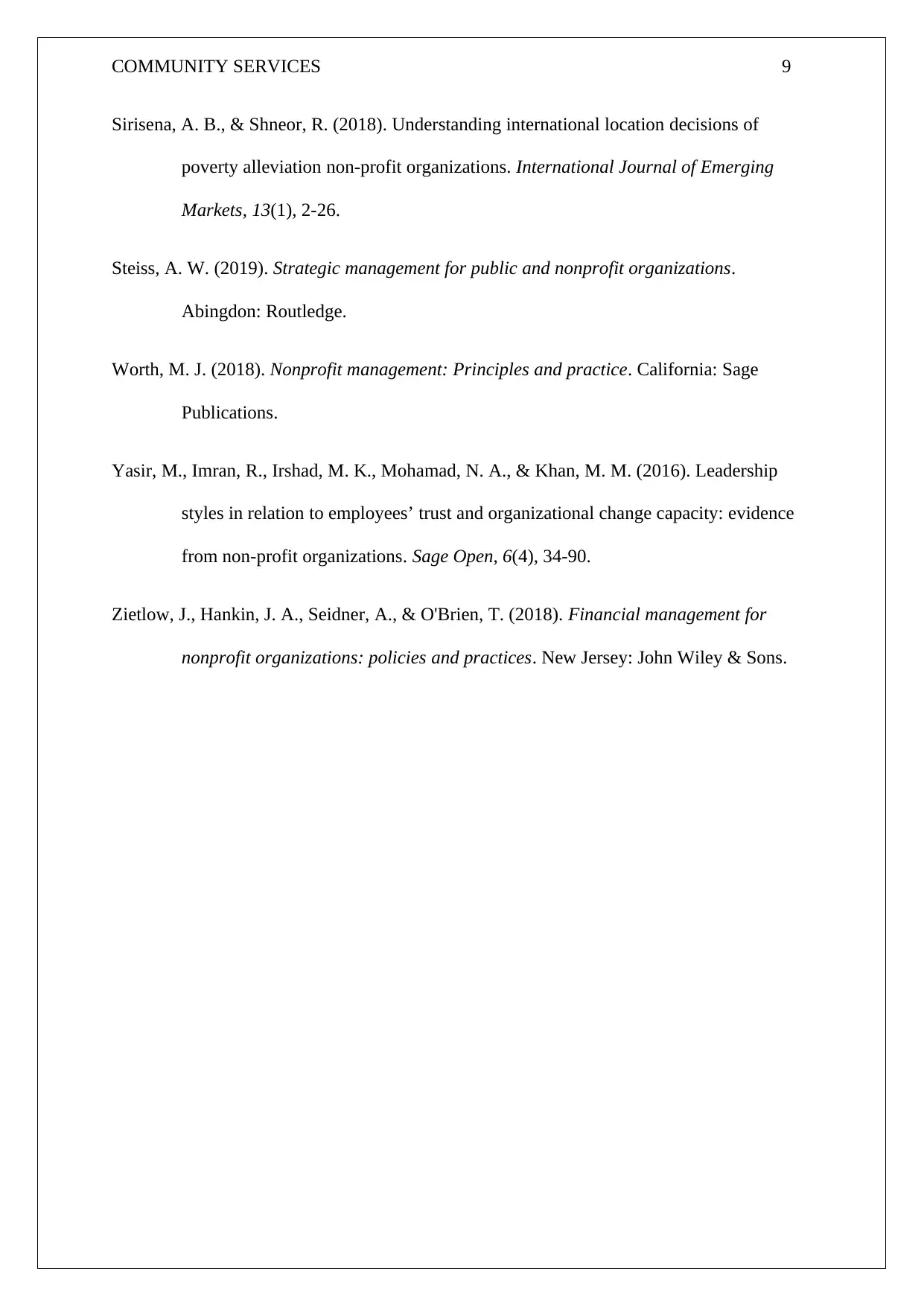
COMMUNITY SERVICES 9
Sirisena, A. B., & Shneor, R. (2018). Understanding international location decisions of
poverty alleviation non-profit organizations. International Journal of Emerging
Markets, 13(1), 2-26.
Steiss, A. W. (2019). Strategic management for public and nonprofit organizations.
Abingdon: Routledge.
Worth, M. J. (2018). Nonprofit management: Principles and practice. California: Sage
Publications.
Yasir, M., Imran, R., Irshad, M. K., Mohamad, N. A., & Khan, M. M. (2016). Leadership
styles in relation to employees’ trust and organizational change capacity: evidence
from non-profit organizations. Sage Open, 6(4), 34-90.
Zietlow, J., Hankin, J. A., Seidner, A., & O'Brien, T. (2018). Financial management for
nonprofit organizations: policies and practices. New Jersey: John Wiley & Sons.
Sirisena, A. B., & Shneor, R. (2018). Understanding international location decisions of
poverty alleviation non-profit organizations. International Journal of Emerging
Markets, 13(1), 2-26.
Steiss, A. W. (2019). Strategic management for public and nonprofit organizations.
Abingdon: Routledge.
Worth, M. J. (2018). Nonprofit management: Principles and practice. California: Sage
Publications.
Yasir, M., Imran, R., Irshad, M. K., Mohamad, N. A., & Khan, M. M. (2016). Leadership
styles in relation to employees’ trust and organizational change capacity: evidence
from non-profit organizations. Sage Open, 6(4), 34-90.
Zietlow, J., Hankin, J. A., Seidner, A., & O'Brien, T. (2018). Financial management for
nonprofit organizations: policies and practices. New Jersey: John Wiley & Sons.
1 out of 10
Related Documents
Your All-in-One AI-Powered Toolkit for Academic Success.
+13062052269
info@desklib.com
Available 24*7 on WhatsApp / Email
![[object Object]](/_next/static/media/star-bottom.7253800d.svg)
Unlock your academic potential
Copyright © 2020–2025 A2Z Services. All Rights Reserved. Developed and managed by ZUCOL.



